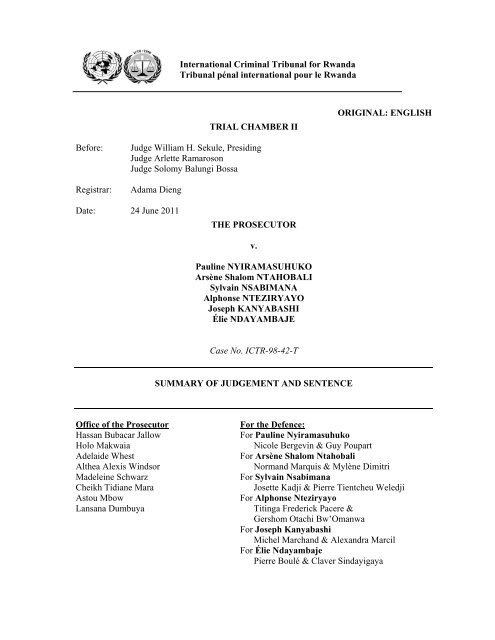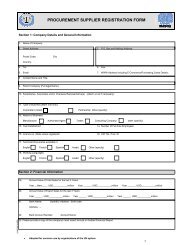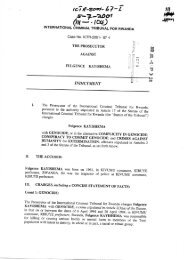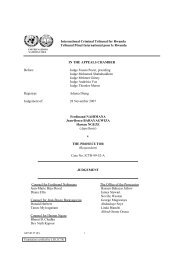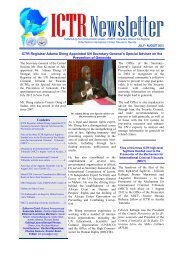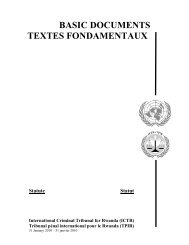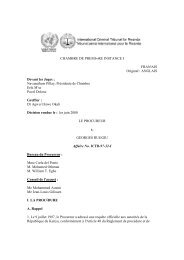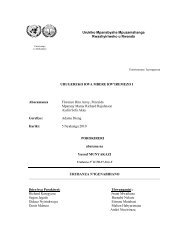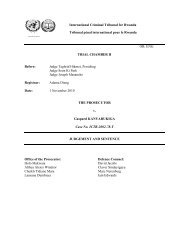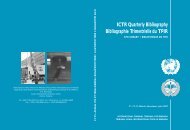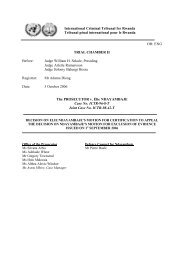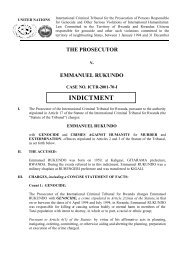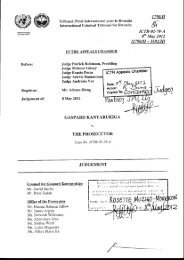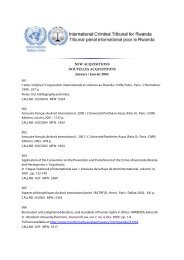Nyiramasuhuko et al. - International Criminal Tribunal for Rwanda
Nyiramasuhuko et al. - International Criminal Tribunal for Rwanda
Nyiramasuhuko et al. - International Criminal Tribunal for Rwanda
Create successful ePaper yourself
Turn your PDF publications into a flip-book with our unique Google optimized e-Paper software.
TRIAL CHAMBER II<br />
Be<strong>for</strong>e: Judge William H. Sekule, Presiding<br />
Judge Arl<strong>et</strong>te Ramaroson<br />
Judge Solomy B<strong>al</strong>ungi Bossa<br />
Registrar: Adama Dieng<br />
Date: 24 June 2011<br />
Internation<strong>al</strong> Crimin<strong>al</strong> Tribun<strong>al</strong> <strong>for</strong> <strong>Rwanda</strong><br />
Tribun<strong>al</strong> pén<strong>al</strong> internation<strong>al</strong> pour le <strong>Rwanda</strong><br />
THE PROSECUTOR<br />
v.<br />
Pauline NYIRAMASUHUKO<br />
Arsène Sh<strong>al</strong>om NTAHOBALI<br />
Sylvain NSABIMANA<br />
Alphonse NTEZIRYAYO<br />
Joseph KANYABASHI<br />
Élie NDAYAMBAJE<br />
Case No. ICTR-98-42-T<br />
SUMMARY OF JUDGEMENT AND SENTENCE<br />
ORIGINAL: ENGLISH<br />
Office of the Prosecutor For the Defence:<br />
Hassan Bubacar J<strong>al</strong>low For Pauline <strong>Nyiramasuhuko</strong><br />
Holo Makwaia Nicole Bergevin & Guy Poupart<br />
Adelaide Whest For Arsène Sh<strong>al</strong>om Ntahob<strong>al</strong>i<br />
Althea Alexis Windsor Normand Marquis & Mylène Dimitri<br />
Madeleine Schwarz For Sylvain Nsabimana<br />
Cheikh Tidiane Mara Jos<strong>et</strong>te Kadji & Pierre Tientcheu Weledji<br />
Astou Mbow For Alphonse Nteziryayo<br />
Lansana Dumbuya Titinga Frederick Pacere &<br />
Gershom Otachi Bw’Omanwa<br />
For Joseph Kanyabashi<br />
Michel Marchand & Alexandra Marcil<br />
For Élie Ndayambaje<br />
Pierre Boulé & Claver Sindayigaya
Prosecutor v. <strong>Nyiramasuhuko</strong> <strong>et</strong> <strong>al</strong>., Case No. ICTR-98-42-T<br />
INTRODUCTION<br />
1. The Chamber will now read out a summary of the Judgement in this case, which will<br />
address the centr<strong>al</strong> findings in the written Judgement. In doing so, the Chamber emphasises that<br />
only the written Judgement is authoritative. It will be made available as soon as possible.<br />
2. This case concerns six Accused: Pauline <strong>Nyiramasuhuko</strong>, the <strong>for</strong>mer Minister of Women’s<br />
Development; her son, Arsène Sh<strong>al</strong>om Ntahob<strong>al</strong>i, who was a student in 1994; Sylvain<br />
Nsabimana, who served as Préf<strong>et</strong> of Butare from 19 April until 17 June 1994; Alphonse<br />
Nteziryayo, a lieutenant colonel in the armed <strong>for</strong>ces who was appointed Préf<strong>et</strong> of Butare on 17<br />
June 1994; Joseph Kanyabashi, the long-serving Bourgmestre of Ngoma commune from 1974<br />
through July 1994; and Élie Ndayambaje, a <strong>for</strong>mer Bourgmestre of Muganza commune who was<br />
reappointed to his post as Bourgmestre on 18 June 1994.<br />
3. The Prosecution has charged each of them with conspiracy to commit genocide; genocide;<br />
complicity in genocide; the crimes against humanity of extermination, murder, persecution, and<br />
other inhumane acts; and violence to life as a war crime. All except <strong>for</strong> Ntahob<strong>al</strong>i are <strong>al</strong>so<br />
charged with direct and public incitement to commit genocide. Fin<strong>al</strong>ly, the Prosecution has<br />
charged <strong>Nyiramasuhuko</strong> and Ntahob<strong>al</strong>i with rape as a crime against humanity, and with outrages<br />
upon person<strong>al</strong> dignity as a war crime. For the most part, each Accused is charged with both<br />
direct and superior responsibility.<br />
4. The Defence teams have ch<strong>al</strong>lenged the credibility of the Prosecution’s evidence. They<br />
have <strong>al</strong>so raised <strong>al</strong>ibis, as well as various procedur<strong>al</strong> ch<strong>al</strong>lenges. These are discussed in the<br />
written Judgement.<br />
5. The Chamber notes that this has been a complex and lengthy case. The Prosecution and the<br />
six Accused presented a tot<strong>al</strong> of 189 witnesses. Almost 13,000 pages of documents were<br />
tendered into evidence, resulting in 913 exhibits. These proceedings have produced more than<br />
125,000 transcript pages. Alongside the proceedings, handling and conclusion of the tri<strong>al</strong>, ten<br />
other cases were interspersed with this case. The Judgement, excluding the annexes, will be<br />
approximately 1500 pages in length.<br />
Summary of Judgement and Sentence 2<br />
24 June 2011
Prosecutor v. <strong>Nyiramasuhuko</strong> <strong>et</strong> <strong>al</strong>., Case No. ICTR-98-42-T<br />
FACTUAL AND LEGAL FINDINGS<br />
6. The Prosecution <strong>al</strong>leges that the six Accused conspired to commit genocide of the Tutsi<br />
<strong>et</strong>hnic group. While the Prosecution’s fin<strong>al</strong> submissions <strong>al</strong>leged various conspiracies, the<br />
Chamber rec<strong>al</strong>ls that principles of fairness require that the Prosecution must be held to the case it<br />
<strong>for</strong>mulated at the beginning of tri<strong>al</strong>. In its Opening Statement, the Prosecution clarified the<br />
charge of conspiracy in the Indictment, <strong>al</strong>leging that <strong>Nyiramasuhuko</strong> conspired with members of<br />
the Interim Government prior to the swearing-in of Nsabimana as Préf<strong>et</strong> of Butare on 19 April<br />
1994. Ntahob<strong>al</strong>i was <strong>al</strong>leged to have participated in a conspiracy with the other Accused by<br />
identifying places where Tutsis would be separated from Hutus. Nsabimana, Nteziryayo,<br />
Kanyabashi, and Ndayambaje were <strong>al</strong>leged to have agreed with the Interim Government’s plan<br />
to kill Tutsis at the ceremony on 19 April. In response, the Defence teams have disputed these<br />
<strong>al</strong>legations as untrue and as unsupported by credible evidence.<br />
7. The evidence established that b<strong>et</strong>ween 9 April 1994 and 14 July 1994, the Interim<br />
Government of which <strong>Nyiramasuhuko</strong> was a member adopted directives and issued instructions<br />
during Cabin<strong>et</strong> me<strong>et</strong>ings. In addition, the Chamber considers that the intention behind these<br />
directives and instructions was to encourage the population to hunt down and take action against<br />
the “enemy” and its “accomplices”; terms which referred to Tutsis in gener<strong>al</strong>. The evidence<br />
established that on 16 or 17 April, <strong>Nyiramasuhuko</strong> agreed with the other members of the Interim<br />
Government to remove Préf<strong>et</strong> Haby<strong>al</strong>imana of Butare préfecture, who had posed an obstacle to<br />
the killing of Tutsis, and to replace him with Nsabimana. On 19 April, she attended the<br />
swearing-in ceremony of Nsabimana, lending further support to the Interim Government’s<br />
decision. On 27 April, the Interim Government, including <strong>Nyiramasuhuko</strong>, issued a Directive<br />
encouraging the population to mount and man roadblocks, with the intention of encouraging the<br />
population to kill Tutsis. As a member of the Interim Government, <strong>Nyiramasuhuko</strong> participated<br />
in many of the Cabin<strong>et</strong> me<strong>et</strong>ings at which the massacre of Tutsis was discussed, and she took<br />
part in the decisions which triggered the onslaught of massacres in Butare préfecture.<br />
Considering <strong>al</strong>l of these elements, the Chamber has found that only one reasonable conclusion<br />
can be reached: <strong>Nyiramasuhuko</strong> entered into an agreement with members of the Interim<br />
Government on or after 9 April 1994 to kill Tutsis within Butare préfecture with the intent to<br />
destroy in whole or in part the Tutsi <strong>et</strong>hnic group. She conspired with the Interim Government to<br />
commit genocide against the Tutsis of Butare préfecture.<br />
Summary of Judgement and Sentence 3<br />
24 June 2011
Prosecutor v. <strong>Nyiramasuhuko</strong> <strong>et</strong> <strong>al</strong>., Case No. ICTR-98-42-T<br />
8. The other Accused were <strong>al</strong>leged to have joined this conspiracy. The Chamber has<br />
considered their involvement in events in Butare préfecture, but because the evidence of their<br />
<strong>al</strong>leged agreement is equivoc<strong>al</strong>, the Chamber finds that the Prosecution has not proven this<br />
<strong>al</strong>legation beyond a reasonable doubt.<br />
9. On 17 April 1994, Préf<strong>et</strong> Haby<strong>al</strong>imana of Butare was removed from office and, two days<br />
later, Nsabimana ascended to Préf<strong>et</strong> in a public ceremony. Many important person<strong>al</strong>ities attended<br />
this ceremony, including <strong>Nyiramasuhuko</strong>, Nsabimana, and Kanyabashi. The Prime Minister of<br />
the Interim Government, as well as the Interim President, <strong>al</strong>so attended, and they both gave<br />
inflammatory speeches that exhorted their listeners to kill Tutsis.<br />
10. The Chamber has found that <strong>Nyiramasuhuko</strong> and Nsabimana remained silent during these<br />
inflammatory speeches and, by doing so, offered their tacit approv<strong>al</strong> of them. Kanyabashi gave<br />
his own speech in which he supported their message and committed to carrying out their<br />
instructions, <strong>al</strong>though this speech was not inflammatory. Bearing in mind the burden of proof,<br />
the Chamber cannot conclude beyond a reasonable doubt that either <strong>Nyiramasuhuko</strong>’s or<br />
Nsabimana’s tacit approv<strong>al</strong>, or Kanyabashi’s offer of support, substanti<strong>al</strong>ly contributed to the<br />
genocide that followed. The Chamber there<strong>for</strong>e has not found that they bear crimin<strong>al</strong><br />
responsibility <strong>for</strong> these actions at Nsabimana’s swearing-in ceremony on 19 April 1994.<br />
11. The following day, 20 April 1994, massive killings of people, mainly of the Tutsi <strong>et</strong>hnic<br />
group, began throughout Butare préfecture. The Tri<strong>al</strong> Chamber has found this amounted to<br />
genocide, as the evidence established that they were committed with the intent to destroy, in<br />
whole or in part, this group. The evidence established that on 20 April, Ndayambaje went to<br />
Mugombwa Church, showed a photograph of President Habyarimana to those taking refuge<br />
inside the Church, and told them that they were going to be killed <strong>for</strong> being accomplices. Armed<br />
assailants then attacked the Tutsis sheltering inside. Ndayambaje r<strong>et</strong>urned the following day, and<br />
incited the crowd to continue killing those in the church. That afternoon, the church was<br />
bombarded by grenades and, as those taking shelter escaped into the courtyard of the church,<br />
they were slaughtered. This two-day attack resulted in the death of hundreds, if not thousands, of<br />
Tutsis. The Chamber has found that Ndayambaje aided and ab<strong>et</strong>ted this attack.<br />
12. Also on 20 April 1994, Ndayambaje travelled to Ngiryi bridge and <strong>for</strong>ced Tutsis who<br />
were trying to flee the country to r<strong>et</strong>urn to Gisagara mark<strong>et</strong>place. They were later escorted to<br />
Kabuye Hill. On 22 April, Ndayambaje was present at Kabuye Hill as soldiers, commune police,<br />
and civilians attacked the Tutsis taking refuge there. Thousands were killed. That night,<br />
Summary of Judgement and Sentence 4<br />
24 June 2011
Prosecutor v. <strong>Nyiramasuhuko</strong> <strong>et</strong> <strong>al</strong>., Case No. ICTR-98-42-T<br />
survivors of the attack were guarded and prevented from escaping. Furthermore, the evidence<br />
established that on 23 April 1994 Ndayambaje distributed weapons including rifles and grenades<br />
at both the Muganza commune office and Kabuye Hill, which were later used in the massacres at<br />
Kabuye Hill on 23 and 24 April 1994. Ndayambaje transported soldiers, civilians and commune<br />
policemen to Kabuye Hill where they participated in attacks against Tutsis. Fin<strong>al</strong>ly, Ndayambaje<br />
was present during the attacks against Tutsis at Kabuye Hill on 23 and 24 April 1994, and<br />
thousands of deaths resulted from these attacks.<br />
13. The Chamber rec<strong>al</strong>ls that Ndayambaje exercised considerable mor<strong>al</strong> authority over the<br />
population in his commune at the time. As such, the Chamber finds that Ndayambaje’s presence<br />
on 22, 23, and 24 April 1994 at Kabuye Hill during the attacks encouraged and substanti<strong>al</strong>ly<br />
contributed to the attacks at Kabuye Hill, and the Chamber is satisfied that Ndayambaje knew<br />
that his presence would be considered by the assailants as tacit approv<strong>al</strong> of the attacks. The<br />
Chamber has there<strong>for</strong>e found that Ndayambaje aided and ab<strong>et</strong>ted these attacks.<br />
14. It is the Chamber’s finding that Ndayambaje’s acts of distributing weapons at both the<br />
Muganza commune office and Kabuye Hill on 23 April 1994, weapons which were used in the<br />
subsequent attacks at Kabuye Hill, as well as transporting soldiers, civilians and commune<br />
policemen to Kabuye Hill, substanti<strong>al</strong>ly contributed to the commission of the crimes at Kabuye<br />
Hill on 23 and 24 April 1994. The Chamber is satisfied that Ndayambaje knew that his positive<br />
acts substanti<strong>al</strong>ly contributed to the commission of the attacks at Kabuye Hill on 23 and 24 April<br />
1994. The Chamber has there<strong>for</strong>e found that Ndayambaje aided and ab<strong>et</strong>ted these attacks.<br />
15. On 21 April, Ntahob<strong>al</strong>i participated in the abduction of some 40 Tutsis at a roadblock, and<br />
ordered the Interahamwe to take them near the IRST. Once there, Ntahob<strong>al</strong>i ordered the<br />
Interahamwe to kill them. All told, approximately 200 Tutsis were killed at the IRST that day.<br />
The Chamber has found that Ntahob<strong>al</strong>i is responsible <strong>for</strong> ordering these killings.<br />
16. The evidence established that, elsewhere in Butare on 21 April, loc<strong>al</strong> authorities and<br />
members of the Interahamwe directed Tutsis to Kabakobwa Hill. At least 500 and up to 10,000<br />
Tutsis went there to take refuge from the ongoing genocide. The next day, soldiers and civilians,<br />
<strong>al</strong>ong with Ngoma commune police officers, launched an attack against these Tutsis. At least<br />
hundreds, if not thousands, were killed. Attackers r<strong>et</strong>urned the following day to finish off any<br />
survivors. The Prosecution did not charge Kanyabashi with ordering this attack, but instead<br />
<strong>al</strong>leged that he is responsible as a superior. After considering the evidence, the Chamber has<br />
found that, in his position as Bourgmestre of Ngoma commune, Kanyabashi bears superior<br />
Summary of Judgement and Sentence 5<br />
24 June 2011
Prosecutor v. <strong>Nyiramasuhuko</strong> <strong>et</strong> <strong>al</strong>., Case No. ICTR-98-42-T<br />
responsibility <strong>for</strong> the participation of Ngoma commune police officers in the attack at<br />
Kabakobwa Hill.<br />
17. The Chamber has <strong>al</strong>so found that Tutsis were killed at Mutunda Stadium around 25 through<br />
27 April. The evidence does not establish however that <strong>Nyiramasuhuko</strong> was present during this<br />
attack, and the Chamber has concluded that neither <strong>Nyiramasuhuko</strong>’s nor Nsabimana’s <strong>al</strong>leged<br />
responsibility <strong>for</strong> this attack has been proven beyond a reasonable doubt.<br />
18. As <strong>for</strong> the events at Matyazo Clinic, the Prosecution <strong>al</strong>leged that Kanyabashi ordered<br />
soldiers to open fire on Tutsis taking refuge there. The Prosecution, however, did not charge<br />
Kanyabashi with ordering these deaths, but instead <strong>al</strong>leged that he is responsible as a superior.<br />
The Chamber considers that this was a serious omission on the part of the Prosecution. The<br />
evidence established that, as Tutsis were sheltering in Matyazo Clinic in late April, Kanyabashi<br />
ordered soldiers to open fire on them, resulting in many deaths. A majority of the Chamber has<br />
found, Judge Ramaroson dissenting, that these soldiers were acting as subordinates of<br />
Kanyabashi, and that Kanyabashi is responsible as a superior <strong>for</strong> these killings.<br />
19. The Prosecution <strong>al</strong>so <strong>al</strong>leged that numerous Tutsis were massacred at the Ngoma Parish<br />
Church at the end of April. After considering the evidence, the Chamber has not found it<br />
established beyond a reasonable doubt that the Accused are crimin<strong>al</strong>ly responsible <strong>for</strong> this<br />
massacre.<br />
20. The Chamber has found that, in late April, a roadblock was s<strong>et</strong> up near Hotel Ihuliro.<br />
Ntahob<strong>al</strong>i manned this roadblock, which he utilised, with the assistance of soldiers and members<br />
of the Interahamwe, to abduct, rape, and kill members of the Tutsi population. The roadblock<br />
outside Hotel Ihuliro earned the reputation of being one of the most terrifying roadblocks in<br />
Butare, and the evidence established that it was the site of numerous beatings, rapes, and killings<br />
of members of the Tutsi <strong>et</strong>hnic group. In this regard, the Chamber has found that Ntahob<strong>al</strong>i<br />
person<strong>al</strong>ly raped and murdered a Tutsi girl there, and ordered the Interahamwe to kill a Tutsi<br />
named Léopold Ruvurajabo at the roadblock. The Chamber has <strong>al</strong>so found that Ntahob<strong>al</strong>i aided<br />
and ab<strong>et</strong>ted the killing of the Rwamukwaya family near the end of April. Because the<br />
Prosecution has not established beyond a reasonable doubt that <strong>Nyiramasuhuko</strong> was present at<br />
the time when any specific crime was perp<strong>et</strong>rated, and adduced insufficient evidence to establish<br />
that she was in a superior-subordinate relationship with anyone involved in these crimes at the<br />
time they occurred, the Chamber has acquitted <strong>Nyiramasuhuko</strong> of this <strong>al</strong>legation.<br />
Summary of Judgement and Sentence 6<br />
24 June 2011
Prosecutor v. <strong>Nyiramasuhuko</strong> <strong>et</strong> <strong>al</strong>., Case No. ICTR-98-42-T<br />
21. The Chamber will now address the Butare préfecture office. By way of introduction, the<br />
Chamber notes that, as these horrific events unfolded throughout Butare, and as the violence in<br />
other parts of <strong>Rwanda</strong> pushed people to seek refuge in places they considered safe like churches<br />
and government offices, numerous <strong>al</strong>ready traumatised, mainly Tutsi, civilians went to the<br />
Butare préfecture office seeking refuge. Hoping to find saf<strong>et</strong>y and security, they instead found<br />
themselves subject to abductions, rapes, and murder. The evidence presented by these survivors,<br />
and accepted by the Chamber, is among the worst encountered by this Chamber; it paints a clear<br />
picture of unfathomable depravity and sadism.<br />
22. The evidence established that, around the end of April, the attacks started at the Butare<br />
préfecture office, when assailants began to abduct and kill civilians seeking shelter there. In mid-<br />
May, <strong>Nyiramasuhuko</strong>, Ntahob<strong>al</strong>i, and about 10 Interahamwe drove to the Butare préfecture<br />
office in a pickup truck. <strong>Nyiramasuhuko</strong> identified Tutsis taking refuge there, and ordered the<br />
Interahamwe to <strong>for</strong>ce them onto the truck. Once full, Ntahob<strong>al</strong>i ordered the Interahamwe to stop<br />
because the vehicle could not accept any more dead. The Tutsis were taken to other parts of<br />
Butare to be killed.<br />
23. The Chamber has <strong>al</strong>so found that, on two occasions in the last h<strong>al</strong>f of May, Ntahob<strong>al</strong>i and<br />
Interahamwe came to the Butare préfecture office. Ntahob<strong>al</strong>i violently raped Witness TA, while<br />
the Interahamwe obeyed his orders and raped six other women. The second time, Ntahob<strong>al</strong>i<br />
ordered about seven Interahamwe to rape this same witness, while he raped another woman.<br />
24. The evidence <strong>al</strong>so proves that further attacks took place in the first h<strong>al</strong>f of June. During<br />
these attacks, <strong>Nyiramasuhuko</strong> ordered Interahamwe to rape Tutsi women, and Ntahob<strong>al</strong>i aided<br />
and ab<strong>et</strong>ted the rape of Witness TA by seven Interahamwe.<br />
25. The Chamber notes that the Indictment clearly charged <strong>Nyiramasuhuko</strong> and Ntahob<strong>al</strong>i with<br />
rape. The Chamber has concluded however that the <strong>Nyiramasuhuko</strong> and Ntahob<strong>al</strong>i Indictment<br />
was defective in failing to plead rape as genocide. Furthermore, this defect was not cured by the<br />
Prosecution. After reading the Indictment as a whole, and taking into account the procedur<strong>al</strong><br />
history outlined in the written Judgement, the Chamber cannot conclude that the Prosecution<br />
pled rapes in support of genocide. Although the evidence establishes in this case that rape was<br />
utilized as a <strong>for</strong>m of genocide, the Chamber has concluded that it would be prejudici<strong>al</strong> to the<br />
Accused to hold them responsible <strong>for</strong> a charge of which they had insufficient notice. There<strong>for</strong>e,<br />
Summary of Judgement and Sentence 7<br />
24 June 2011
Prosecutor v. <strong>Nyiramasuhuko</strong> <strong>et</strong> <strong>al</strong>., Case No. ICTR-98-42-T<br />
the Chamber has not taken the rapes into account when assessing genocide and has not entered a<br />
conviction <strong>for</strong> genocide on the basis of rape.<br />
26. The Chamber notes that rapes were clearly charged in support of the counts of rape as a<br />
crime against humanity, and outrages upon person<strong>al</strong> dignity as a war crime. The Chamber has<br />
there<strong>for</strong>e considered rapes in the context of these <strong>al</strong>legations. In this regard, however, the<br />
Chamber notes a serious omission by the Prosecution. Although the evidence clearly established<br />
<strong>Nyiramasuhuko</strong>’s direct role in ordering Interahamwe to rape Tutsi women at the Butare<br />
préfecture office, the Prosecution only charged <strong>Nyiramasuhuko</strong> with responsibility as a superior<br />
<strong>for</strong> rape. There<strong>for</strong>e the Chamber has only assessed <strong>Nyiramasuhuko</strong>’s superior responsibility <strong>for</strong><br />
the rapes at the Butare préfecture office. The evidence established that she, indeed, had superior<br />
responsibility over Interahamwe who committed rapes at the Butare préfecture office.<br />
27. In sum, the Chamber has found that b<strong>et</strong>ween around the end of April and around mid-June<br />
1994, <strong>Nyiramasuhuko</strong>, Ntahob<strong>al</strong>i, Interahamwe, and soldiers went to the Butare préfecture office<br />
to abduct hundreds of Tutsis. Many were physic<strong>al</strong>ly assaulted, raped, abducted, and taken away<br />
to various places in Butare, where they were killed. During the course of these repeated attacks<br />
on vulnerable civilians, both <strong>Nyiramasuhuko</strong> and Ntahob<strong>al</strong>i ordered killings. They <strong>al</strong>so ordered<br />
rapes. Ntahob<strong>al</strong>i further committed rapes, and <strong>Nyiramasuhuko</strong> aided and ab<strong>et</strong>ted rapes and is<br />
responsible as a superior <strong>for</strong> rapes committed by members of the Interahamwe.<br />
28. The Chamber has found that Nsabimana, as Préf<strong>et</strong> of Butare, had a leg<strong>al</strong> duty to act to<br />
protect the civilians at the Butare préfecture office. In particular, the Chamber notes that the<br />
<strong>Rwanda</strong>n Pen<strong>al</strong> Code imposes an obligation on every <strong>Rwanda</strong>n citizen to provide assistance to<br />
persons in danger where it would not cause risk to oneself, and failure to do so is a crimin<strong>al</strong><br />
offense. Further, under <strong>Rwanda</strong>n domestic law, Nsabimana had an obligation to ensure the<br />
tranquillity, public order, and security of people within his préfecture. The Geneva Conventions<br />
<strong>al</strong>so impose a leg<strong>al</strong> duty on Nsabimana to protect civilians, including the wounded and sick,<br />
against acts or threats of violence.<br />
29. The evidence established that Nsabimana knew of the genocid<strong>al</strong> attacks being perp<strong>et</strong>rated<br />
upon Tutsis taking refuge at the préfecture office. On multiple occasions, Tutsis asked<br />
Nsabimana directly <strong>for</strong> protection from the ongoing attacks. Nsabimana knew that those taking<br />
refuge were being abducted, raped, and killed. In this regard, the Chamber rec<strong>al</strong>ls Nsabimana’s<br />
Summary of Judgement and Sentence 8<br />
24 June 2011
Prosecutor v. <strong>Nyiramasuhuko</strong> <strong>et</strong> <strong>al</strong>., Case No. ICTR-98-42-T<br />
testimony that after he learned of the massacres, he would go home at night fearing that the<br />
refugees would not be at the Butare préfecture office when he r<strong>et</strong>urned in the morning.<br />
30. The Chamber has found that Nsabimana requisitioned armed <strong>for</strong>ces around 5 to 15 June,<br />
after which soldiers came to the Butare préfecture office. These soldiers succeeded in<br />
<strong>for</strong>est<strong>al</strong>ling attacks against those taking refuge there. Taking this into account, the Chamber has<br />
found that Nsabimana had the ability to act to prevent the attacks at the Butare préfecture office.<br />
Even if the presence of the armed <strong>for</strong>ce may not have been able to stop the attacks <strong>al</strong>tog<strong>et</strong>her, the<br />
evidence establishes that their presence would have <strong>al</strong>leviated the situation of recurring<br />
abductions, rapes, and killings.<br />
31. While Nsabimana may have discharged his leg<strong>al</strong> duty when he requisitioned these <strong>for</strong>ces in<br />
June, it is clear that he did nothing <strong>for</strong> a significant period of time be<strong>for</strong>e that point in time. The<br />
Chamber rec<strong>al</strong>ls that genocid<strong>al</strong> attacks were ongoing from the end of April until around mid-<br />
June at the Butare préfecture office and, in light of this, the Chamber has found that Nsabimana’s<br />
failure to discharge his leg<strong>al</strong> duty be<strong>for</strong>e June had a substanti<strong>al</strong> effect on the perp<strong>et</strong>ration of these<br />
crimes. There<strong>for</strong>e, the Chamber has concluded that Nsabimana aided and ab<strong>et</strong>ted, by omission,<br />
the attacks and killings at the Butare préfecture office during this time period.<br />
32. The Chamber has <strong>al</strong>so found that persons taking refuge at the Butare préfecture office were<br />
transferred to other locations with similarly deplorable conditions, often on the arrangements of<br />
Nsabimana or Kanyabashi. Tutsis were transferred in this way to the École Évangeliste du<br />
<strong>Rwanda</strong> (EER), to Nyange secteur, and to Rango Forest. The Chamber, however, has not<br />
concluded that these transfers constituted a crime <strong>for</strong> which Nsabimana or Kanyabashi could be<br />
held responsible. In contrast, the evidence establishes that after Tutsis were transferred to the<br />
École Évangeliste du <strong>Rwanda</strong> (EER), Ntahob<strong>al</strong>i and Interahamwe members abducted and killed<br />
them in the nearby woods. The Chamber has found that Ntahob<strong>al</strong>i aided and ab<strong>et</strong>ted these<br />
killings. Soldiers <strong>al</strong>so participated in attacks, rapes, and killings at the École Évangeliste du<br />
<strong>Rwanda</strong> (EER). The Prosecution charged Nsabimana with responsibility as a superior <strong>for</strong> the<br />
actions of the soldiers at the École Évangeliste du <strong>Rwanda</strong> (EER), however the Prosecution has<br />
not proven this <strong>al</strong>legation.<br />
33. It has <strong>al</strong>so been established that, around late May, Kanyabashi drove through Butare town<br />
and, using a megaphone, incited the population to search <strong>for</strong> and kill Tutsis. Again in June,<br />
Summary of Judgement and Sentence 9<br />
24 June 2011
Prosecutor v. <strong>Nyiramasuhuko</strong> <strong>et</strong> <strong>al</strong>., Case No. ICTR-98-42-T<br />
Kanyabashi used a megaphone to publicly incite further killings. The Chamber has there<strong>for</strong>e<br />
found that Kanyabashi directly and publicly incited the commission of genocide.<br />
34. As <strong>for</strong> Nteziryayo, it is clear from the evidence that he replaced Nsabimana as préf<strong>et</strong> on 17<br />
June. The Chamber has found beyond a reasonable doubt that Nteziryayo, at a me<strong>et</strong>ing in<br />
Muyaga commune around mid-June, referred to Tutsis as “lice”, whose “eggs” needed to be<br />
destroyed. At another me<strong>et</strong>ing in Kibayi commune around mid- to late June, he c<strong>al</strong>led upon the<br />
population to abduct and kill Tutsi women married to Hutus, and to flush out Tutsi children and<br />
kill them. Nteziryayo <strong>al</strong>so incited the population to continue killing Tutsis at Ndayambaje’s<br />
swearing-in ceremony on 22 June in Muganza commune. The Chamber has there<strong>for</strong>e found that<br />
Nteziryayo directly and publicly incited the commission of genocide. The Chamber notes that,<br />
<strong>al</strong>though Nteziryayo is implicated in three instances of incitement, it has not been established<br />
that his conduct contributed to any specific instances of killing.<br />
35. The Chamber has found that, on 22 June, Ndayambaje was sworn in as Bourgmestre of<br />
Muganza commune at a public ceremony near the Muganza commune office, during which he<br />
incited the population to kill more Tutsis. Afterwards, searches were conducted to locate Tutsis,<br />
and Tutsi women and girls were abducted near the Statue of the Virgin Mary. During the<br />
abduction, Ndayambaje arrived and told the abductors that they were free to do what they wanted<br />
with the girls. The evidence establishes that, following Ndayambaje’s instigation, the assailants<br />
slaughtered the group at a brick factory at Gasenyi.<br />
36. More gener<strong>al</strong>ly, the Chamber has found that civil defence <strong>for</strong>ces were organised be<strong>for</strong>e<br />
April 1994, and that they received training and weapons in May and June. Both Nteziryayo and<br />
Kanyabashi played a role in these training exercises, and in the distribution of weapons.<br />
Furthermore, the Chamber has found that Nteziryayo was an offici<strong>al</strong> in charge of the civil<br />
defence. However, because these events occurred at the same time as the RPF advance towards<br />
Butare préfecture, a reasonable inference remains that they may have been done to <strong>for</strong>est<strong>al</strong>l the<br />
RPF incursion. The Chamber there<strong>for</strong>e has not found it established that Nteziryayo and<br />
Kanyabashi bear crimin<strong>al</strong> responsibility <strong>for</strong> these actions.<br />
VERDICT<br />
37. For the reasons s<strong>et</strong> out in the written Judgement, having considered <strong>al</strong>l evidence and<br />
submissions of the Parties, the Tri<strong>al</strong> Chamber finds unanimously in respect of:<br />
Summary of Judgement and Sentence 10<br />
24 June 2011
PAULINE NYIRAMASUHUKO as follows:<br />
Prosecutor v. <strong>Nyiramasuhuko</strong> <strong>et</strong> <strong>al</strong>., Case No. ICTR-98-42-T<br />
38. On Count One of the Indictment, Conspiracy to Commit Genocide, the Chamber finds you<br />
GUILTY <strong>for</strong> entering into an agreement with members of the Interim Government on or after 9<br />
April 1994 to kill Tutsis in Butare préfecture.<br />
39. On Count Two of the Indictment, Genocide, the Chamber finds you GUILTY <strong>for</strong> ordering<br />
the killing of Tutsis taking refuge at the Butare préfecture office.<br />
40. On Count Three of the Indictment, Complicity in Genocide, the Chamber DISMISSES the<br />
charge because it is pled as an <strong>al</strong>ternative to Genocide.<br />
41. On Count Four of the Indictment, Direct and Public Incitement to Commit Genocide, the<br />
Chamber finds you NOT GUILTY.<br />
42. On Count Five of the Indictment, Murder as a Crime Against Humanity, the Chamber<br />
DISMISSES the charge because it is cumulative of Extermination as a Crime Against Humanity.<br />
43. On Count Six of the Indictment, Extermination as a Crime Against Humanity, the Chamber<br />
finds you GUILTY <strong>for</strong> ordering the killing of Tutsis taking refuge at the Butare préfecture office.<br />
44. On Count Seven of the Indictment, Rape as a Crime Against Humanity, the Chamber finds<br />
you GUILTY as a superior of the Interahamwe who raped Tutsis taking refuge at the Butare<br />
préfecture office.<br />
45. On Count Eight of the Indictment, Persecution as a Crime Against Humanity, the Chamber<br />
finds you GUILTY <strong>for</strong> ordering the killing of Tutsis taking refuge at the Butare préfecture office.<br />
46. On Count Nine of the Indictment, Other Inhumane Acts as a Crime Against Humanity, the<br />
Chamber finds you NOT GUILTY.<br />
47. On Count Ten of the Indictment, Violence to Life as a War Crime, the Chamber finds you<br />
GUILTY <strong>for</strong> ordering the killing of Tutsis taking refuge at the Butare préfecture office.<br />
Summary of Judgement and Sentence 11<br />
24 June 2011
Prosecutor v. <strong>Nyiramasuhuko</strong> <strong>et</strong> <strong>al</strong>., Case No. ICTR-98-42-T<br />
48. On Count Eleven of the Indictment, Outrages upon Person<strong>al</strong> Dignity as a War Crime, the<br />
Chamber finds you GUILTY as a superior of the Interahamwe who raped Tutsis taking refuge at<br />
the Butare préfecture office.<br />
ARSÈNE SHALOM NTAHOBALI as follows:<br />
49. On Count One of the Indictment, Conspiracy to Commit Genocide, the Chamber finds you<br />
NOT GUILTY.<br />
50. On Count Two of the Indictment, Genocide, the Chamber finds you GUILTY <strong>for</strong> killing<br />
Tutsis at the Hotel Ihuliro roadblock, including the murder of a Tutsi girl, ordering the killing of<br />
Léopold Ruvurajabo at the Hotel Ihuliro roadblock, ordering the killing of about 200 Tutsis at<br />
the IRST, ordering the killings of Tutsis taking refuge at the Butare préfecture office, aiding and<br />
ab<strong>et</strong>ting the killing of the Rwamukwaya family, and aiding and ab<strong>et</strong>ting the killing of Tutsis<br />
abducted from the École Évangeliste du <strong>Rwanda</strong> (EER).<br />
51. On Count Three of the Indictment, Complicity in Genocide, the Chamber DISMISSES the<br />
charge because it is pled as an <strong>al</strong>ternative to Genocide.<br />
52. The Indictment does not charge you with a Count Four.<br />
53. On Count Five of the Indictment, Murder as a Crime Against Humanity, the Chamber<br />
DISMISSES the charge because it is cumulative of Extermination as a Crime Against Humanity.<br />
54. On Count Six of the Indictment, Extermination as a Crime Against Humanity, the Chamber<br />
finds you GUILTY <strong>for</strong> killing Tutsis at the Hotel Ihuliro roadblock, including the murder of a<br />
Tutsi girl, ordering the killing of Léopold Ruvurajabo at the Hotel Ihuliro roadblock, ordering the<br />
killing of about 200 Tutsis at the IRST, ordering the killings of Tutsis taking refuge at the Butare<br />
préfecture office, aiding and ab<strong>et</strong>ting the killing of the Rwamukwaya family, and aiding and<br />
ab<strong>et</strong>ting the killing of Tutsis abducted from the École Évangeliste du <strong>Rwanda</strong> (EER).<br />
55. On Count Seven of the Indictment, Rape as a Crime Against Humanity, the Chamber finds<br />
you GUILTY <strong>for</strong> committing rapes at the Hotel Ihuliro roadblock and at the Butare préfecture<br />
office, and <strong>for</strong> ordering and aiding and ab<strong>et</strong>ting rapes at the Butare préfecture office.<br />
Summary of Judgement and Sentence 12<br />
24 June 2011
Prosecutor v. <strong>Nyiramasuhuko</strong> <strong>et</strong> <strong>al</strong>., Case No. ICTR-98-42-T<br />
56. On Count Eight of the Indictment, Persecution as a Crime Against Humanity, the Chamber<br />
finds you GUILTY <strong>for</strong> killing Tutsis at the Hotel Ihuliro roadblock, including the murder of a<br />
Tutsi girl, ordering the killing of Léopold Ruvurajabo at the Hotel Ihuliro roadblock, ordering the<br />
killing of about 200 Tutsis at the IRST, ordering the killings of Tutsis taking refuge at the Butare<br />
préfecture office, aiding and ab<strong>et</strong>ting the killing of the Rwamukwaya family, and aiding and<br />
ab<strong>et</strong>ting the killing of Tutsis abducted from the École Évangeliste du <strong>Rwanda</strong> (EER).<br />
57. On Count Nine of the Indictment, Other Inhumane Acts as a Crime Against Humanity, the<br />
Chamber finds you NOT GUILTY.<br />
58. On Count Ten of the Indictment, Violence to Life as a War Crime, the Chamber finds you<br />
GUILTY <strong>for</strong> killing Tutsis at the Hotel Ihuliro roadblock, including the murder of a Tutsi girl,<br />
ordering the killing of Léopold Ruvurajabo at the Hotel Ihuliro roadblock, ordering the killing of<br />
about 200 Tutsis at the IRST, ordering the killings of Tutsis taking refuge at the Butare<br />
préfecture office, aiding and ab<strong>et</strong>ting the killing of the Rwamukwaya family, and aiding and<br />
ab<strong>et</strong>ting the killing of Tutsis abducted from the École Évangeliste du <strong>Rwanda</strong> (EER).<br />
59. On Count Eleven of the Indictment, Outrages upon Person<strong>al</strong> Dignity as a War Crime, the<br />
Chamber finds you GUILTY <strong>for</strong> committing rapes at the Hotel Ihuliro roadblock and at the<br />
Butare préfecture office, and <strong>for</strong> ordering and aiding and ab<strong>et</strong>ting rapes at the Butare préfecture<br />
office.<br />
SYLVAIN NSABIMANA as follows:<br />
60. On Count One of the Indictment, Conspiracy to Commit Genocide, the Chamber finds you<br />
NOT GUILTY.<br />
61. On Count Two of the Indictment, Genocide, the Chamber finds you GUILTY <strong>for</strong> failing to<br />
discharge your leg<strong>al</strong> duty, and thereby aiding and ab<strong>et</strong>ting the killing of Tutsis taking refuge at<br />
the Butare préfecture office.<br />
62. On Count Three of the Indictment, Complicity in Genocide, the Chamber DISMISSES the<br />
charge because it is pled as an <strong>al</strong>ternative to Genocide.<br />
Summary of Judgement and Sentence 13<br />
24 June 2011
Prosecutor v. <strong>Nyiramasuhuko</strong> <strong>et</strong> <strong>al</strong>., Case No. ICTR-98-42-T<br />
63. On Count Four of the Indictment, Direct and Public Incitement to Commit Genocide, the<br />
Chamber finds you NOT GUILTY.<br />
64. On Count Five of the Indictment, Murder as a Crime Against Humanity, the Chamber<br />
DISMISSES the charge because it is cumulative of Extermination as a Crime Against Humanity.<br />
65. On Count Six of the Indictment, Extermination as a Crime Against Humanity, the Chamber<br />
finds you GUILTY <strong>for</strong> failing to discharge your leg<strong>al</strong> duty, and thereby aiding and ab<strong>et</strong>ting the<br />
killing of Tutsis taking refuge at the Butare préfecture office.<br />
66. On Count Seven of the Indictment, Persecution as a Crime Against Humanity, the Chamber<br />
finds you GUILTY <strong>for</strong> failing to discharge your leg<strong>al</strong> duty, and thereby aiding and ab<strong>et</strong>ting the<br />
killing of Tutsis taking refuge at the Butare préfecture office.<br />
67. On Count Eight of the Indictment, Other Inhumane Acts as a Crime Against Humanity, the<br />
Chamber finds you NOT GUILTY.<br />
68. On Count Nine of the Indictment, Violence to Life as a War Crime, the Chamber finds you<br />
GUILTY <strong>for</strong> failing to discharge your leg<strong>al</strong> duty, and thereby aiding and ab<strong>et</strong>ting the killing of<br />
Tutsis taking refuge at the Butare préfecture office.<br />
ALPHONSE NTEZIRYAYO as follows:<br />
69. On Count One of the Indictment, Conspiracy to Commit Genocide, the Chamber finds you<br />
NOT GUILTY.<br />
70. On Count Two of the Indictment, Genocide, the Chamber finds you NOT GUILTY.<br />
71. On Count Three of the Indictment, Complicity in Genocide, the Chamber finds you NOT<br />
GUILTY.<br />
72. On Count Four of the Indictment, Direct and Public Incitement to Commit Genocide, the<br />
Chamber finds you GUILTY <strong>for</strong> your speeches at two commune me<strong>et</strong>ings in June, and <strong>for</strong> your<br />
speech at Ndayambaje’s swearing-in ceremony on 22 June 1994.<br />
Summary of Judgement and Sentence 14<br />
24 June 2011
Prosecutor v. <strong>Nyiramasuhuko</strong> <strong>et</strong> <strong>al</strong>., Case No. ICTR-98-42-T<br />
73. On Count Five of the Indictment, Murder as a Crime Against Humanity, the Chamber finds<br />
you NOT GUILTY.<br />
74. On Count Six of the Indictment, Extermination as a Crime Against Humanity, the Chamber<br />
finds you NOT GUILTY.<br />
75. On Count Seven of the Indictment, Persecution as a Crime Against Humanity, the Chamber<br />
finds you NOT GUILTY.<br />
76. On Count Eight of the Indictment, Other Inhumane Acts as a Crime Against Humanity, the<br />
Chamber finds you NOT GUILTY.<br />
77. On Count Nine of the Indictment, Violence to Life as a War Crime, the Chamber finds you<br />
NOT GUILTY.<br />
JOSEPH KANYABASHI as follows:<br />
78. On Count One of the Indictment, Conspiracy to Commit Genocide, the Chamber finds you<br />
NOT GUILTY.<br />
79. On Count Two of the Indictment, Genocide, the Chamber finds you GUILTY as a superior<br />
of Ngoma commune policemen who killed Tutsis at Kabakobwa Hill, and a majority of the<br />
Chamber, Judge Ramaroson dissenting, finds you GUILTY as a superior of soldiers who killed<br />
Tutsis at Matyazo Clinic.<br />
80. On Count Three of the Indictment, Complicity in Genocide, the Chamber DISMISSES the<br />
charge because it is pled as an <strong>al</strong>ternative to Genocide.<br />
81. On Count Four of the Indictment, Direct and Public Incitement to Commit Genocide, the<br />
Chamber finds you GUILTY <strong>for</strong> your megaphone announcements in May and June 1994.<br />
82. On Count Five of the Indictment, Murder as a Crime Against Humanity, the Chamber<br />
DISMISSES the charge because it is cumulative of Extermination as a Crime Against Humanity.<br />
Summary of Judgement and Sentence 15<br />
24 June 2011
Prosecutor v. <strong>Nyiramasuhuko</strong> <strong>et</strong> <strong>al</strong>., Case No. ICTR-98-42-T<br />
83. On Count Six of the Indictment, Extermination as a Crime Against Humanity, the Chamber<br />
finds you GUILTY as a superior of Ngoma commune policemen who killed Tutsis at Kabakobwa<br />
Hill, and a majority of the Chamber, Judge Ramaroson dissenting, finds you GUILTY as a<br />
superior of soldiers who killed Tutsis at Matyazo Clinic.<br />
84. On Count Seven of the Indictment, Persecution as a Crime Against Humanity, the Chamber<br />
finds you GUILTY as a superior of Ngoma commune policemen who killed Tutsis at Kabakobwa<br />
Hill, and a majority of the Chamber, Judge Ramaroson dissenting, finds you GUILTY as a<br />
superior of soldiers who killed Tutsis at Matyazo Clinic.<br />
85. On Count Eight of the Indictment, Other Inhumane Acts as a Crime Against Humanity, the<br />
Chamber finds you NOT GUILTY.<br />
86. On Count Nine of the Indictment, Violence to Life as a War Crime, the Chamber finds you<br />
GUILTY as a superior of Ngoma commune policemen who killed Tutsis at Kabakobwa Hill, and<br />
a majority of the Chamber, Judge Ramaroson dissenting, finds you GUILTY as a superior of<br />
soldiers who killed Tutsis at Matyazo Clinic.<br />
ÉLIE NDAYAMBAJE as follows:<br />
87. On Count One of the Indictment, Conspiracy to Commit Genocide, the Chamber finds you<br />
NOT GUILTY.<br />
88. On Count Two of the Indictment, Genocide, the Chamber finds you GUILTY <strong>for</strong> aiding<br />
and ab<strong>et</strong>ting the killing of Tutsis at Mugombwa Church and at Kabuye Hill, and <strong>for</strong> instigating<br />
the killing of Tutsis after your swearing-in ceremony on 22 June 1994.<br />
89. On Count Three of the Indictment, Complicity in Genocide, the Chamber DISMISSES the<br />
charge because it is pled as an <strong>al</strong>ternative to Genocide.<br />
90. On Count Four of the Indictment, Direct and Public Incitement to Commit Genocide, the<br />
Chamber finds you GUILTY <strong>for</strong> your inciting statements at Mugombwa Church and at your<br />
swearing-in ceremony on 22 June 1994.<br />
Summary of Judgement and Sentence 16<br />
24 June 2011
Prosecutor v. <strong>Nyiramasuhuko</strong> <strong>et</strong> <strong>al</strong>., Case No. ICTR-98-42-T<br />
91. On Count Five of the Indictment, Murder as a Crime Against Humanity, the Chamber<br />
DISMISSES the charge because it is cumulative of Extermination as a Crime Against Humanity.<br />
92. On Count Six of the Indictment, Extermination as a Crime Against Humanity, the Chamber<br />
finds you GUILTY <strong>for</strong> aiding and ab<strong>et</strong>ting the killing of Tutsis at Mugombwa Church and at<br />
Kabuye Hill, and <strong>for</strong> instigating the killing of Tutsis after your swearing-in ceremony on 22 June<br />
1994.<br />
93. On Count Seven of the Indictment, Persecution as a Crime Against Humanity, the Chamber<br />
finds you GUILTY <strong>for</strong> aiding and ab<strong>et</strong>ting the killing of Tutsis at Mugombwa Church and at<br />
Kabuye Hill, and <strong>for</strong> instigating the killing of Tutsis after your swearing-in ceremony on 22 June<br />
1994.<br />
94. On Count Eight of the Indictment, Other Inhumane Acts as a Crime Against Humanity, the<br />
Chamber finds you NOT GUILTY.<br />
95. On Count Nine of the Indictment, Violence to Life as a War Crime, the Chamber finds you<br />
GUILTY <strong>for</strong> aiding and ab<strong>et</strong>ting the killing of Tutsis at Mugombwa Church and at Kabuye Hill,<br />
and <strong>for</strong> instigating the killing of Tutsis after your swearing-in ceremony on 22 June 1994.<br />
96. The Chamber notes that it has found that the Accused are not guilty in relation to the<br />
remaining <strong>al</strong>legations charged by the Prosecution. These are addressed in the written Judgement.<br />
SENTENCING<br />
97. In considering sentencing, the Chamber has taken into account the individu<strong>al</strong>, aggravating,<br />
and mitigating circumstances of each Accused. The Chamber <strong>al</strong>so rec<strong>al</strong>ls that the gravity of the<br />
offences is the deciding factor in the d<strong>et</strong>ermination of the sentence. These have been fully<br />
d<strong>et</strong>ailed in the Judgement. The Chamber has the discr<strong>et</strong>ion to impose a single sentence and<br />
chooses to do so.<br />
98. The Chamber invites the six Accused to stand.<br />
99. Pauline <strong>Nyiramasuhuko</strong>, the Chamber has found you guilty of conspiracy to commit<br />
genocide, genocide, the crimes against humanity of extermination, rape and persecution, and the<br />
Summary of Judgement and Sentence 17<br />
24 June 2011
Prosecutor v. <strong>Nyiramasuhuko</strong> <strong>et</strong> <strong>al</strong>., Case No. ICTR-98-42-T<br />
war crimes of violence to life and outrages upon person<strong>al</strong> dignity. For these crimes, and<br />
considering <strong>al</strong>l relevant circumstances, the Chamber sentences you to life imprisonment.<br />
100. Arsène Sh<strong>al</strong>om Ntahob<strong>al</strong>i, the Chamber has found you guilty of genocide, the crimes<br />
against humanity of extermination, rape and persecution, and the war crimes of violence to life<br />
and outrages upon person<strong>al</strong> dignity. For these crimes, and considering <strong>al</strong>l relevant circumstances,<br />
the Chamber sentences you to life imprisonment.<br />
101. Sylvain Nsabimana, the Chamber has found you guilty of genocide, the crimes against<br />
humanity of extermination and persecution, and violence to life as a war crime. For these crimes,<br />
and considering <strong>al</strong>l relevant circumstances, the Chamber sentences you to 25 years’<br />
‘imprisonment.<br />
102. Alphonse Nteziryayo, the Chamber has found you guilty of direct and public incitement to<br />
commit genocide. For this crime, and considering <strong>al</strong>l relevant circumstances, the Chamber<br />
sentences you to 30 years’ imprisonment.<br />
103. Joseph Kanyabashi, the Chamber has found you guilty of genocide, direct and public<br />
incitement to commit genocide, the crimes against humanity of extermination and persecution,<br />
and violence to life as a war crime. For these crimes, and considering <strong>al</strong>l relevant circumstances,<br />
the Chamber sentences you to 35 years’ imprisonment.<br />
104. Élie Ndayambaje, the Chamber has found you guilty of genocide, direct and public<br />
incitement to commit genocide, the crimes against humanity of extermination and persecution,<br />
and violence to life as a war crime. For these crimes, and considering <strong>al</strong>l relevant circumstances,<br />
the Chamber sentences you to life imprisonment.<br />
105. <strong>Nyiramasuhuko</strong>, Ntahob<strong>al</strong>i, Nsabimana, Nteziryayo, Kanyabashi, and Ndayambaje sh<strong>al</strong>l<br />
receive credit <strong>for</strong> time served since their arrest, where applicable, and they sh<strong>al</strong>l be kept in<br />
d<strong>et</strong>ention under the present conditions until their transfer to their designated places of<br />
imprisonment.<br />
CONCLUSION<br />
106. This has been the summary of the Judgement, and the tri<strong>al</strong> proceedings in this case have<br />
now come to a close. The Chamber thanks <strong>al</strong>l those involved in this case.<br />
Summary of Judgement and Sentence 18<br />
24 June 2011


